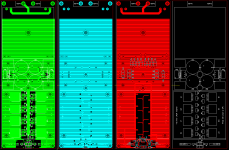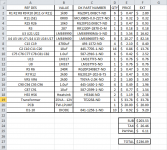A NEW RUN OF THESE BOARDS IS NOW AVAILABLE! PLEASE SEE THE FOLLOWING THREAD FOR DETAILS:
http://www.diyaudio.com/forums/soli...ble-here-bal-bal-se-se-lpuhp.html#post3516741
Hi Guys,
Well, here we go again... but this will definitely be the last in the series for at least a year while I work on something a little more involved.
What is it? It's basically a version of The Wire headphone amp on steroids that is meant to drive your loudspeakers! You're looking at either a differential or SE input, followed by 8 parallel LME49600 buffers. This gives roughly 1.42 ARMS of output current, and a voltage swing or roughly +/- 15 V or close to 11 VRMS. If you're driving an 8 ohm load, it's good for about 15-16 watts before distortion creeps above 1%. It has 18dB of gain, so you get full power output into 8 ohms with about 1.3VRMS input. The gain is easily adjustable to suit your needs.
What is it good for? Well, if you have reasonably high efficiency loudspeakers, and don't need ear bleeding levels of output, then this is bar-none the best measuring amplifier I have ever seen or used. It also has something special and a little unique about the way it sounds. There's something strangely romantic about it, like a really good low power SE tube amp, but without the fuzzy haze that usually comes along with that category.
How did it come to be? As with several of my other projects, I had some empty space on a PCB panel and couldn't let it go to waste, so I designed this and laid it out in a few days, and a little to my surprise, it just kinda worked! I also had been thinking about the concept of it after having used the BAL-BAL version of The Wire headphone amp to drive some 100dB/2.83V/1m loudspeakers I was measuring and testing. With the BAL-BAL headphone amp, the output was almost high enough, but I could still get it to clip if I pushed it too hard. That's basically how this thing was born.
Each board is a complete monoblock amplifier, including the power transformer, a fully regulated +/-18V PSU, balanced or SE input, a heatsink for the output buffers, and the loudspeaker outputs. You just build it, plug it in, and go. It measures 2.5" w x 6.8" l x 1.8” h so it will easily fit in a variety of extruded aluminum enclosures, making it a very easy project to complete.
How about technical merits? Well, with lower output power, and very low idle dissipation, a fully regulated supply is actually realistic to implement. Add to that the extremely high PSRR of the amplifier itself and you get a noise floor that sits at about -147dB with a few 60Hz (and associated harmonics) creeping up to -130dB. I was using this with a driver that was 103dB/2.83V/1m and I couldn’t hear anything with my ear right against the cone. It’s that quiet.
As for distortion, it’s the first time I can honestly say “un-measureable” for a power amp. The measurements are attached, but if you loop the AP back into itself, you get the exact same thing, so there’s just nothing there. Same applies to IMD.
How about frequency response? Well, if you use the LME49990 as specified, then you’ll be ruler-flat to well past 100kHz at full power without any problem. Trying front-end op-amps with higher slew rates will likely get you much higher.
So what are the downsides? It’s simple… power and cost. You don’t get a huge amount of output power, but generally speaking you get more than enough for most applications. With very high efficiency speakers (95-100dB) you’ll get painful levels without any problem. With high efficiency (90-95dB you’ll get very loud levels without any problem. If your speakers are lower efficiency than that, you start to give up output. As for cost, the output stage is a little on the expensive side. It’s close to
$100 just for the buffers and op-amps, and the total cost if you order all the parts from Digikey is about $205 plus taxes and shipping per channel.
This leads me to the next question… I have 50 boards total, and I’m not sure if I should bother offering kits or not. I would need everyone to order a kit, so if the numbers are 50/50 it’s not really worthwhile. I’ve settled on $20 per board for the PCB, and if you include all the parts with taxes and Paypal, it’s basically $239 per channel including the PCB. That’s by far the most expensive kit I’ve ever offered, but on the plus side, it’s genuinely complete, including the transformer and every required part.
Is there any interest in this? Is there anyone out there looking for a reference level amplifier with lower output power? As always, questions and comments are welcome!
Cheers,
Owen
http://www.diyaudio.com/forums/soli...ble-here-bal-bal-se-se-lpuhp.html#post3516741
Hi Guys,
Well, here we go again... but this will definitely be the last in the series for at least a year while I work on something a little more involved.
What is it? It's basically a version of The Wire headphone amp on steroids that is meant to drive your loudspeakers! You're looking at either a differential or SE input, followed by 8 parallel LME49600 buffers. This gives roughly 1.42 ARMS of output current, and a voltage swing or roughly +/- 15 V or close to 11 VRMS. If you're driving an 8 ohm load, it's good for about 15-16 watts before distortion creeps above 1%. It has 18dB of gain, so you get full power output into 8 ohms with about 1.3VRMS input. The gain is easily adjustable to suit your needs.
What is it good for? Well, if you have reasonably high efficiency loudspeakers, and don't need ear bleeding levels of output, then this is bar-none the best measuring amplifier I have ever seen or used. It also has something special and a little unique about the way it sounds. There's something strangely romantic about it, like a really good low power SE tube amp, but without the fuzzy haze that usually comes along with that category.
How did it come to be? As with several of my other projects, I had some empty space on a PCB panel and couldn't let it go to waste, so I designed this and laid it out in a few days, and a little to my surprise, it just kinda worked! I also had been thinking about the concept of it after having used the BAL-BAL version of The Wire headphone amp to drive some 100dB/2.83V/1m loudspeakers I was measuring and testing. With the BAL-BAL headphone amp, the output was almost high enough, but I could still get it to clip if I pushed it too hard. That's basically how this thing was born.
Each board is a complete monoblock amplifier, including the power transformer, a fully regulated +/-18V PSU, balanced or SE input, a heatsink for the output buffers, and the loudspeaker outputs. You just build it, plug it in, and go. It measures 2.5" w x 6.8" l x 1.8” h so it will easily fit in a variety of extruded aluminum enclosures, making it a very easy project to complete.
How about technical merits? Well, with lower output power, and very low idle dissipation, a fully regulated supply is actually realistic to implement. Add to that the extremely high PSRR of the amplifier itself and you get a noise floor that sits at about -147dB with a few 60Hz (and associated harmonics) creeping up to -130dB. I was using this with a driver that was 103dB/2.83V/1m and I couldn’t hear anything with my ear right against the cone. It’s that quiet.
As for distortion, it’s the first time I can honestly say “un-measureable” for a power amp. The measurements are attached, but if you loop the AP back into itself, you get the exact same thing, so there’s just nothing there. Same applies to IMD.
How about frequency response? Well, if you use the LME49990 as specified, then you’ll be ruler-flat to well past 100kHz at full power without any problem. Trying front-end op-amps with higher slew rates will likely get you much higher.
So what are the downsides? It’s simple… power and cost. You don’t get a huge amount of output power, but generally speaking you get more than enough for most applications. With very high efficiency speakers (95-100dB) you’ll get painful levels without any problem. With high efficiency (90-95dB you’ll get very loud levels without any problem. If your speakers are lower efficiency than that, you start to give up output. As for cost, the output stage is a little on the expensive side. It’s close to
$100 just for the buffers and op-amps, and the total cost if you order all the parts from Digikey is about $205 plus taxes and shipping per channel.
This leads me to the next question… I have 50 boards total, and I’m not sure if I should bother offering kits or not. I would need everyone to order a kit, so if the numbers are 50/50 it’s not really worthwhile. I’ve settled on $20 per board for the PCB, and if you include all the parts with taxes and Paypal, it’s basically $239 per channel including the PCB. That’s by far the most expensive kit I’ve ever offered, but on the plus side, it’s genuinely complete, including the transformer and every required part.
Is there any interest in this? Is there anyone out there looking for a reference level amplifier with lower output power? As always, questions and comments are welcome!
Cheers,
Owen
Attachments
-
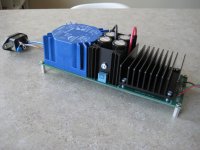 IMG_7014.JPG327.2 KB · Views: 15,190
IMG_7014.JPG327.2 KB · Views: 15,190 -
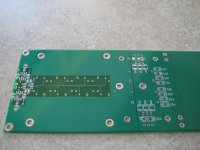 IMG_7025.JPG327.7 KB · Views: 2,797
IMG_7025.JPG327.7 KB · Views: 2,797 -
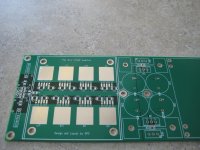 IMG_7024.JPG339.2 KB · Views: 3,706
IMG_7024.JPG339.2 KB · Views: 3,706 -
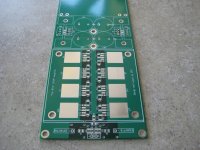 IMG_7023.JPG352.3 KB · Views: 3,434
IMG_7023.JPG352.3 KB · Views: 3,434 -
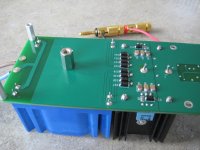 IMG_7020.JPG287.9 KB · Views: 2,774
IMG_7020.JPG287.9 KB · Views: 2,774 -
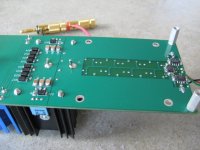 IMG_7019.JPG283.6 KB · Views: 3,848
IMG_7019.JPG283.6 KB · Views: 3,848 -
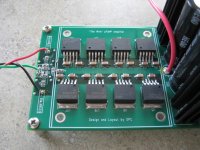 IMG_7021.JPG349.1 KB · Views: 13,247
IMG_7021.JPG349.1 KB · Views: 13,247 -
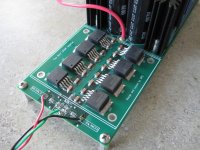 IMG_7022.JPG352.4 KB · Views: 13,456
IMG_7022.JPG352.4 KB · Views: 13,456 -
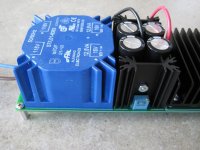 IMG_7016.JPG296.6 KB · Views: 13,550
IMG_7016.JPG296.6 KB · Views: 13,550 -
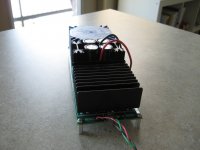 IMG_7015.JPG259.9 KB · Views: 14,009
IMG_7015.JPG259.9 KB · Views: 14,009
Last edited:
Attached are the measurements. As mentioned above, looping the AP directly, input to output, gives exactly the same thing except for the noise floor which is the amplifier itself. Any of the distortion measurements fall into the realm of "un-measureable".
Cheers,
Owen
Cheers,
Owen
Attachments
-
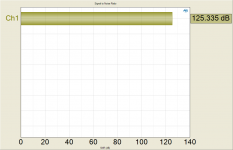 Signal to Noise Ratio.png41.6 KB · Views: 1,013
Signal to Noise Ratio.png41.6 KB · Views: 1,013 -
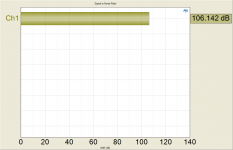 Signal to Noise Ratio 1W.png41.9 KB · Views: 1,099
Signal to Noise Ratio 1W.png41.9 KB · Views: 1,099 -
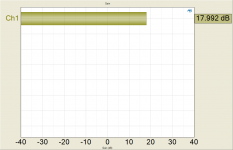 Gain.png44 KB · Views: 1,341
Gain.png44 KB · Views: 1,341 -
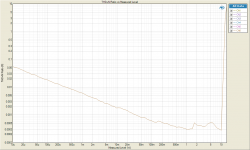 THD+N Ratio vs Measured Level W 8R.png90.5 KB · Views: 1,470
THD+N Ratio vs Measured Level W 8R.png90.5 KB · Views: 1,470 -
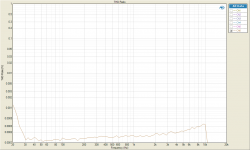 THD Ratio vs. freq 10W.png60.5 KB · Views: 1,389
THD Ratio vs. freq 10W.png60.5 KB · Views: 1,389 -
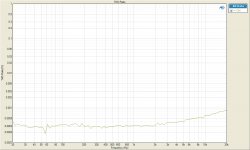 THD Ratio vs freq 8W.png58.4 KB · Views: 1,555
THD Ratio vs freq 8W.png58.4 KB · Views: 1,555 -
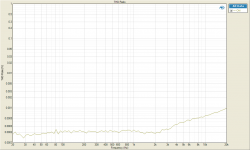 THD Ratio vs freq 1W.png59 KB · Views: 1,774
THD Ratio vs freq 1W.png59 KB · Views: 1,774 -
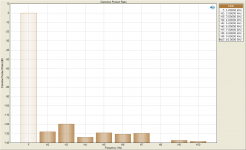 Distortion Product Ratio 1.15V.png47.3 KB · Views: 2,304
Distortion Product Ratio 1.15V.png47.3 KB · Views: 2,304 -
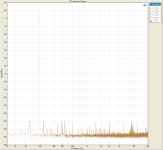 FFT Spectrum Monitor - with input all bal.png95.9 KB · Views: 3,119
FFT Spectrum Monitor - with input all bal.png95.9 KB · Views: 3,119
yeah i'd be in for a couple of pcbs to try on my tweeters and maybe show off at the next headfi meet for low efficiency planar magnetic headphones, saying 'you call that a headphone amp?' 'THIS is a headphone amp!!'
as far as full kits though hmm, its not something that i need in a hurry so i would probably just buy the parts in dribs and drabs with other orders as well as using stuff already in my parts bin, probably even my own transformer as i have a couple that would suit, so a kit wouldnt be of much interest to me on this one.
nice work BTW, i knew this was coming, but seeing it, it just looks so over the top lol
as far as full kits though hmm, its not something that i need in a hurry so i would probably just buy the parts in dribs and drabs with other orders as well as using stuff already in my parts bin, probably even my own transformer as i have a couple that would suit, so a kit wouldnt be of much interest to me on this one.
nice work BTW, i knew this was coming, but seeing it, it just looks so over the top lol
Last edited:
It's really the current limit on the LME49600 that limits the power. You get about 250-270mA peak from each buffer, so the overall current limit happens at between 2-2.16A peak for the 8 buffers. If you used a higher voltage op-amp, and the LME49610 then you could run the rails right up to +/-22V which would net you about very close to 20W into a 9 ohm load.
The LME49600 actually allows quite a bit more more current during short bursts, but rating power than way can quickly become misleading.
If you needed more power but wanted to take a similar approach, then you'd need to look at bridged outputs with about 40 buffers. That would give you roughly 26 VRMS and 3.3 ARMS into 8 ohms for roughly 85W. The cost of that would be pretty obscene though
Cheers,
Owen
The LME49600 actually allows quite a bit more more current during short bursts, but rating power than way can quickly become misleading.
If you needed more power but wanted to take a similar approach, then you'd need to look at bridged outputs with about 40 buffers. That would give you roughly 26 VRMS and 3.3 ARMS into 8 ohms for roughly 85W. The cost of that would be pretty obscene though
Cheers,
Owen
Wow, regardless of how much my hearing might deteriorate I could use that to drive my Senns  Can it be partially populated in terms of buffers -- I mean until I really need 'em?
Can it be partially populated in terms of buffers -- I mean until I really need 'em?
On the serious side, I would be in for a couple (maybe three) boards of your design if all they did was heat my garage; not in kits. There is a lot of ten+ year-old Aragon iron in the closet barely broken in, testimonial to how little the speakers get used.
On the serious side, I would be in for a couple (maybe three) boards of your design if all they did was heat my garage; not in kits. There is a lot of ten+ year-old Aragon iron in the closet barely broken in, testimonial to how little the speakers get used.
I thought as much, but thought perhaps dissipation might play a key due to as you say, the lme being capable of peak power of something like 450ma from memory. i was mainly asking out of interest, for my purposes driving tweeters only i cant see me getting close to maxing it out. but it could look pretty cool with a northbridge or GPU fanforced copper heatsink; perhaps i could even make up a novelty 18-16awg cable for my jh13 customs, with an ITC Cannon umbilical connector and try and keep a straight face at the meet haha
Last edited:
IanAS:
I think there are two reasons for that:
1. Higher noise - Paralleling more buffers seems to have a negative impact on the noise floor.
2. My setup for that inital parallel test wasn't the best (I simply soldered another buffer in parallel onto the pins of an old BAL-SE headphone amp)
I think both of the above things made for a higher than normal noise floor which made for an actual audible difference in background noise with my IEMs.
To be honest, I still don't suggest running the buffers in parallel unless you really need to. In this case, if you're driving loudspeakers, you really do need the extra current.
If you were to use this for a headphone amp, you would really need to be positive that you actually required the additional current, since I think for headphone use, the normal headphone amp would be better.
Are there examples out there of headphones that really need this much current?
I'm a firm believer that you should always use what you need, and never more. Having more than you need always brings added negative side effects, and by definition never gives you anything in return.
Wolfsin:
Yes, you can populate all 8 of the buffers, or as few as one of them. It purely depends on how much current you need.
Cheers,
Owen
I think there are two reasons for that:
1. Higher noise - Paralleling more buffers seems to have a negative impact on the noise floor.
2. My setup for that inital parallel test wasn't the best (I simply soldered another buffer in parallel onto the pins of an old BAL-SE headphone amp)
I think both of the above things made for a higher than normal noise floor which made for an actual audible difference in background noise with my IEMs.
To be honest, I still don't suggest running the buffers in parallel unless you really need to. In this case, if you're driving loudspeakers, you really do need the extra current.
If you were to use this for a headphone amp, you would really need to be positive that you actually required the additional current, since I think for headphone use, the normal headphone amp would be better.
Are there examples out there of headphones that really need this much current?
I'm a firm believer that you should always use what you need, and never more. Having more than you need always brings added negative side effects, and by definition never gives you anything in return.
Wolfsin:
Yes, you can populate all 8 of the buffers, or as few as one of them. It purely depends on how much current you need.
Cheers,
Owen
Last edited:
Banned
Joined 2002
Owen, yes the head direct HE6, a high end planar magnetic/orthodynamic headphone is pretty popular at the moment and hungry, maybe just out of reach for the bal-bal. people are mostly using low power speaker amps for them. also the old AKG K1000 basically IS a set of speakers strapped rather awkwardly to the head. some old sennheiser headphones were also known to need more.
so yes there could easily be some people that build this to drive headphones, in fact it would be pretty much the perfect amp for them, many are using too much power and thus higher noise amps for the HE6. some are using low power aleph's, F3's one famously silly chipamp is designed for them, that i shall not name
so yes there could easily be some people that build this to drive headphones, in fact it would be pretty much the perfect amp for them, many are using too much power and thus higher noise amps for the HE6. some are using low power aleph's, F3's one famously silly chipamp is designed for them, that i shall not name
This is a very interesting project i think ill follow and possibly buy parts & boards ( are they for sale ? )
yes, but the format is not yet decided. common man, read the first post, the thread is only 2 pages long
Banned
Joined 2002
yes, but the format is not yet decided. common man, read the first post, the thread is only 2 pages long
was drooling over pictures and got to excited :O
Will look at buying 4 boards
it could look pretty cool with a northbridge or GPU fanforced copper heatsink
I was visualising it with one of those cpu coolers with heat pipes wrapping around the pcb and having the heat sink hanging out the back of a speaker enclosure ...
Banned
Joined 2002
another great project. Put me down for 1 board plz!
1 board = 1 channel...
- Home
- Amplifiers
- Solid State
- The Wire - Low Power Ultra High Perfromance (LPUHP) 16W Power Amplifier
